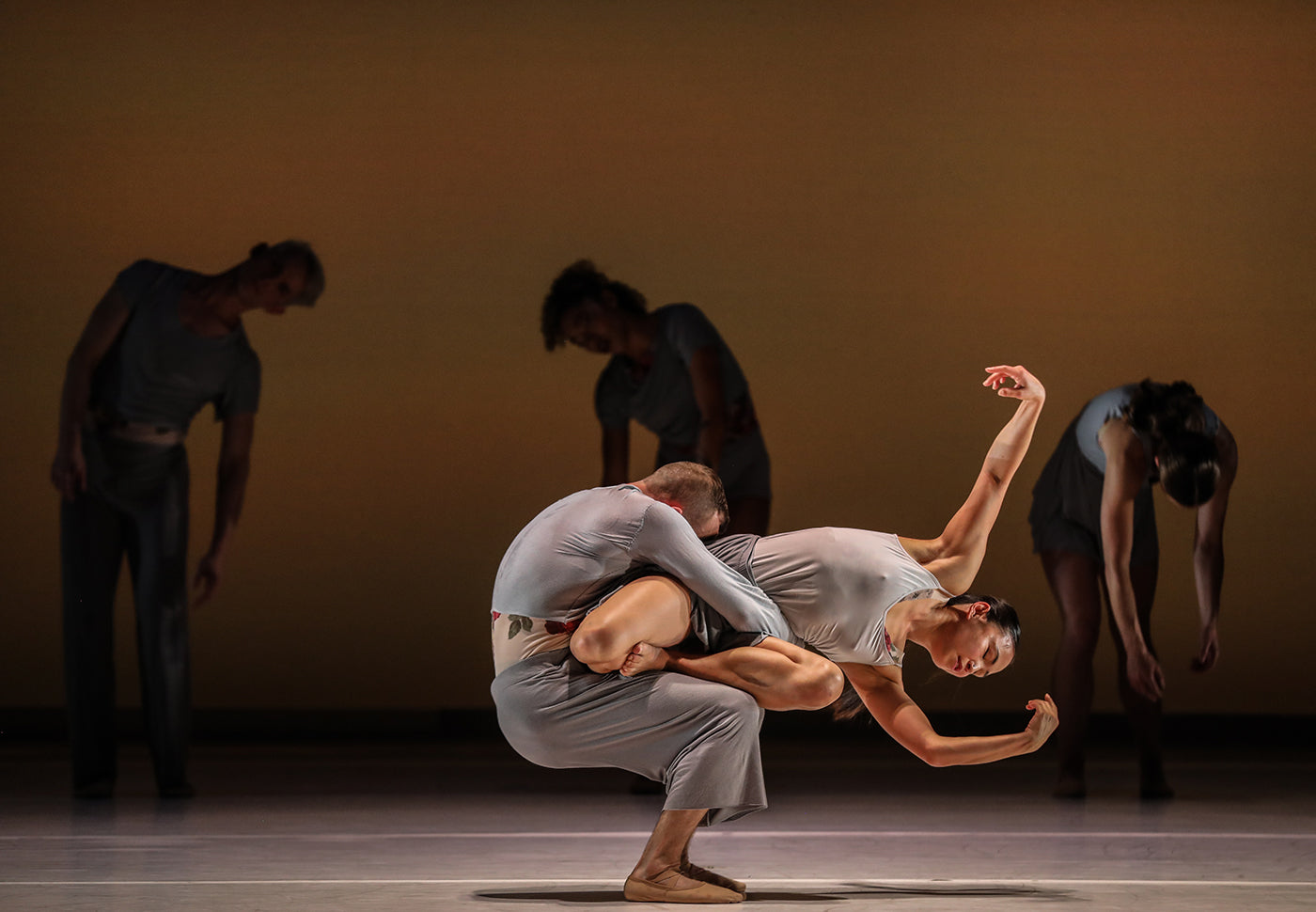Program 7 of the festival was impressive in its choreographic range, presenting ballets by Justin Peck, Mauro Bigonzetti, Troy Schumacher, Liam Scarlett, and Peter Martins. This program was notable for one more reason: two of the five featured choreographers, Peck and Schumacher, both soloists with the company, danced in their own works.
Peck’s “Rodeo: Four Dance Episodes” (2015) concluded the evening and was the program’s undisputable highlight. This ballet grows only richer with each repeated viewing, retaining its freshness and youthful swagger as well as its strong emotional appeal.
In his “Rodeo,” Peck gives special prominence to the male roster of the company, casting 15 guys and only one ballerina, thus inverting the conventional norm of classical ballet. He sets his men on a stirring physical—and emotional—journey, all underpinned by the momentous score that Aaron Copland composed for Agnes de Mille’s iconic “Rodeo” (1942).
Over the course of the piece, the dancers reveal themselves not only as prodigious athletes but also as compassionate individuals and trusted friends. Peck enhances and expands the blithe and airy atmosphere evoked by the music in his own way, creating an original choreographic idiom that is vast, spacious, and genuinely humane. Amid the vigorous rushing on and off the stage, amid the flow of sculptural poses and formal groups, we witness – and admire – these men’s togetherness, their strong emotional bond, their sense of community and comradery.
Their unyielding trust is especially evident in a poignant quintet set to poetic melancholy of “Corral Nocturne.” Taylor Stanley, who originated the leading role in this section, was at the top of his game, dancing with great expressivity and fluid style. His able comrades, Devin Alberda, Daniel Applebaum, Preston Chamblee, and Andrew Scordato, were quick to offer support when he needed it.
The spritely Daniel Ulbricht commanded attention with his impeccable technique and perfect comic timing, claiming the wittiest moments of the ballet. Wonderfully spontaneous and appealingly earthy, Peck himself excelled in the role of the lucky man who gets to dance with the only girl on this transformative ranch. The role of the girl was performed with a nice sensitivity by Brittany Pollack.
Mauro Bigonzetti’s “Oltremare” (2008), the program’s middle act, came across as a potent piece of theatrical dance at once dramatically stirring and utterly relevant. The title translates as “beyond the sea;” and the ballet, aided by the urgently compelling music by Bruno Moretti, depicts the conflicted emotions of a group of immigrants aboard a ship heading towards the unknown, their whole life packed in one dilapidated suitcase.
Dressed in simple street clothes, the cast, in a series of emotionally wrenching scenes, expressed the joys and sorrows, dreams and fears of the people who left everything behind – their homeland and their loved ones – to find a new beginning in a far away world. It’s a big ensemble piece, but ultimately the ballet belonged to the leading dancers.
The outstanding Andrew Veyette brought immense intensity and a sense of anguish to his dynamic, folksy solo. Maria Kowroski and Tyler Angle filled their duet with heart-rending, shattering vulnerability; and the partnership between Tiler Peck and Peter Walker was marked by both unrestrained erotic desire and relentless exasperation as they rippled through space with raw, all-encompassing force as if trying to mend one big open wound that this journey left on their troubled souls.
The program began with an assortment of short ballets: Peter Martins’s indestructible “Ash,” Liam Scarlett’s magnetic “Funérailles,” and Troy Schumacher’s vibrant “Common Ground.”
What really drives and sustains “Ash,” a high-energy piece Martins created in 1991, is its music – Michael Torke’s propulsive, adrenaline-charged composition of the same title. It sounds both modern and utterly classic; it’s Beethoven, Ravel and Philip Glass merged in one unrelenting stream of triumphant sound or rather the endless variation on the same triumphant phrase that keeps listeners in a continuous state of elation and suspense. Martins’s choreography, however, is doggedly symmetrical and somewhat repetitive yet he keeps his dancers in perpetual motion: the movement never stops.
Watching “Ash” is like witnessing a master class in speedy classical dancing; and on this front, NYCB’s crew is without peers. It was a flawless, breathtaking performance delivered by all, with the superb Taylor Stanley and Ashly Isaacs aptly leading the team of four supporting couples.
Liam Scarlett’s wry and hauntingly beautiful duet to piano music of Franz Liszt, “Funérailles,” from 2014, brought a welcome change of pace and atmosphere to the proceedings. This piece was also a fashion statement in its own right: the costumes by Sarah Burton of Alexander McQueen, particularly the sumptuous dress, were not only stunning to look at but also became part of the choreography itself. Every time Jared Angle lifted the exquisite Tiler Peck skyward, her black-and-white gown – a long, intricately layered number with a voluminous feathery skirt – would assume a dance of its own, shimmering and flowing in the air, beautifully accentuating and enhancing every movement of the ballerina. Bare-chested, wearing a Baroque-styled embroidered frock coat, Angle looked part Casanova, part Dracula, giving a tinge of romance noir to this enigmatic and evocative pas de deux.
The first act of the program culminated with the lively performance of Schumacher’s “Common Ground,” a brilliant concoction of vivid colors and spirited movements, accompanied by the pulsating music by Ellis Ludwig-Leone (the score was commissioned specifically for this work.)
Everything about this evanescent piece speaks volume. Its bright energy is intoxicating; its ingenious style pleases the eye and feels organic and natural. When the seven dancers take to the air, they evoke colorful kites gliding up and beyond – easy and free – thanks to the unbound imagination of Schumacher and the creative costumes by Marta Marques and Paulo Almeida of Marques’Almeida.
With such variety of styles, music, and fashion, how refreshing and inspiring a night at the ballet can be!









comments